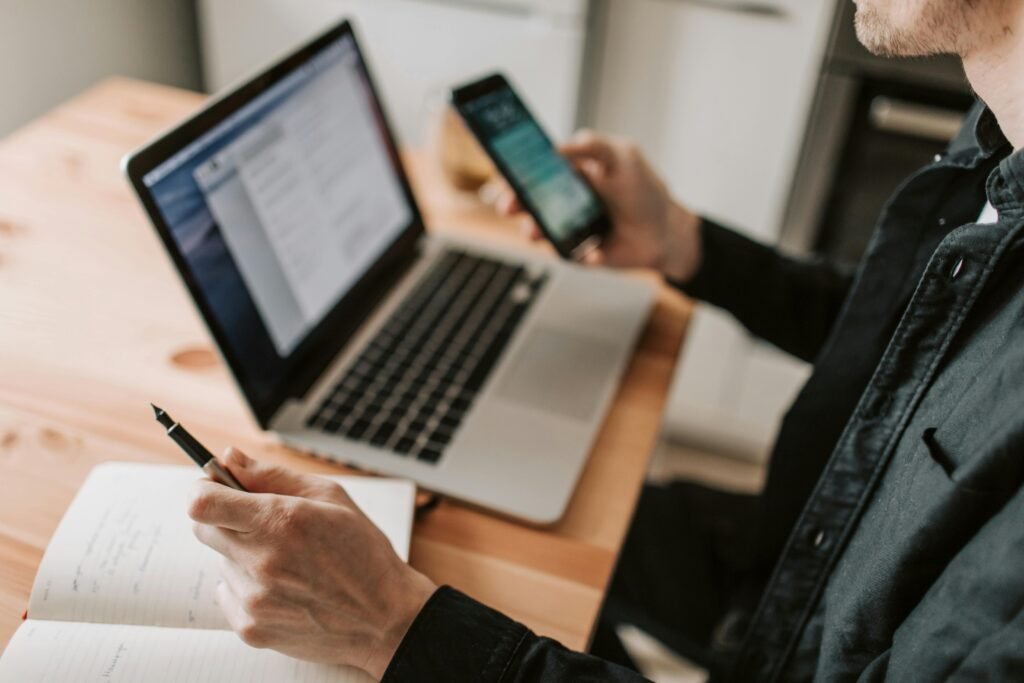
Understanding Multitasking
Multitasking involves engaging in multiple activities, either by rapidly switching between them or handling them concurrently.
It’s a common misconception that multitasking means doing several things at once with equal focus and efficiency.
The reality is more nuanced.
Each task demands a certain amount of attention, and our brain is not naturally wired to give full focus to multiple tasks simultaneously.
Different tasks require different approaches.
Simple or routine activities, like folding laundry while listening to a podcast, can be done concurrently without significant loss of quality.
However, more complex tasks that demand deep concentration, such as writing a report or analyzing data, might suffer if attempted simultaneously with other demanding tasks.
Recognizing the nature of each task is key to effective multitasking.
Our brains are more adept at handling multiple tasks when one or more of those tasks are habitual or less cognitively demanding.
For instance, an experienced driver might find it easy to listen to an audiobook while navigating familiar roads.
But introduce a new, challenging route, and suddenly, that driver may need to pause the audiobook to concentrate fully on driving.
An essential component of mastering multitasking is knowing when to switch gears.
This is where strategies such as chunking, or breaking down tasks into manageable pieces, come into play.
For example, you might allocate specific times of the day for email responses, project planning, and team meetings, ensuring that each activity gets the attention it requires without constant, unproductive switching.
It’s also crucial to be mindful of the potential cognitive overload that can occur when juggling too many tasks.
This overload can lead to increased stress and reduced productivity.
Setting boundaries, like designated work periods and regular breaks, can help manage this load effectively.
Effective multitasking doesn’t mean doing everything at once but rather efficiently managing your time and energy to accomplish multiple objectives.
Identifying which tasks can be paired together and which require undivided attention will help you make the most of your efforts.
The Science Behind Multitasking

Understanding how the brain processes tasks simultaneously is essential to effective multitasking.
When the brain attempts to manage multiple activities at once, it often leads to divided attention.
This division can significantly impact both focus and efficiency.
Research has shown that multitasking can reduce productivity by up to 40% as the brain struggles to prioritize tasks effectively.
Additionally, in the workplace, 71.1% of American workers feel pressured to respond to emails after work hours, which can negatively affect their mental health and lead to burnout.
This illustrates the importance of managing multitasking efficiently to maintain well-being and performance.
When engaging in multitasking, the brain uses a process called “context switching,” which refers to the time it takes to shift focus from one task to another.
Each switch can take several minutes, which adds up and leads to a loss of productive time.
This is why multitasking might feel more exhausting and less rewarding than focusing on one task at a time.
Moreover, certain tasks are more susceptible to the negative effects of multitasking.
Activities requiring critical thinking, creativity, or deep focus can suffer significantly when attempted alongside other demanding tasks.
In contrast, pairing a cognitively demanding task with a more routine one can be more manageable.
For instance, listening to music while working on a repetitive task may be less detrimental to productivity than trying to write an in-depth report while participating in a video conference.
Another key aspect to consider is cognitive overload.
The brain has a limited capacity for processing information, and when that limit is reached, performance drops.
Cognitive overload can manifest as stress, mistakes, and mental fatigue.
Setting clear boundaries and taking regular breaks can help mitigate these effects, ensuring that multitasking doesn’t become overwhelming.
Recognizing the science behind multitasking empowers you to use strategies that align with how the brain works best.
By understanding these dynamics, you can create a more efficient and balanced approach to handling multiple tasks, ultimately leading to better productivity and well being.
Strategies for Effective Multitasking

Prioritizing tasks based on importance and urgency is a cornerstone of effective multitasking.
One popular method is the Eisenhower Matrix, which helps individuals classify tasks into categories such as urgent and important.
Another powerful strategy is setting clear goals for each task.
This clarity ensures that you remain focused on the objectives, making it easier to transition between tasks without losing momentum.
Breaking down larger tasks into smaller, manageable steps, also known as chunking, can help maintain focus and efficiency.
This method allows you to tackle one piece at a time, reducing the feeling of being overwhelmed.
Time blocking is another effective approach.
By allocating specific time periods for different tasks, you create a structured schedule that minimizes the need for constant switching.
For example, you might dedicate the first hour of your workday to responding to emails, the next two hours to project planning, and so on.
This method ensures that each task receives dedicated attention, improving overall productivity.
Leveraging technology can also boost your multitasking abilities.
Task management apps and digital calendars can help you organize your responsibilities and set reminders, ensuring you stay on track.
Additionally, using productivity tools that integrate with your workflow, like project management software or communication platforms, can streamline your processes and reduce the time spent on manual coordination.
Incorporating regular breaks into your schedule is crucial.
The Pomodoro Technique, which involves working for 25 minutes followed by a 5-minute break, can help maintain high levels of concentration.
These short breaks prevent burnout and allow your brain to recharge, ultimately enhancing your ability to multitask effectively.
Lastly, cultivating a mindful approach to multitasking can make a significant difference.
Being aware of your limits and recognizing when you need to slow down can prevent cognitive overload.
Practicing mindfulness techniques, such as deep breathing or short meditation sessions, can help clear your mind and improve focus.
By applying these strategies, you can enhance your multitasking skills, making it possible to manage multiple tasks efficiently while maintaining high standards of quality.
Tools to Enhance Multitasking

Incorporating technology can significantly enhance your multitasking abilities.
Many people overlook the power of using dedicated time management systems.
Exploring apps and software designed for task management can streamline your workflow.
Additionally, 26% of employees use messaging apps for team collaboration, and 10% for client communication, demonstrating the effectiveness of digital tools in enhancing communication and task coordination.
Project management tools like Trello or Asana can help you organize tasks, set deadlines, and track progress all in one place.
These platforms often integrate with other software, allowing for seamless coordination and reducing the need to switch between multiple applications.
For those who find it challenging to manage their time effectively, time tracking apps like Toggl or Clockify can provide insights into how your time is spent throughout the day.
These tools can help identify areas where you might be losing productivity and allow you to adjust your schedule accordingly.
Communication tools such as Slack or Microsoft Teams can centralize your conversations and files, making it easier to collaborate with colleagues without the constant back and forth of emails.
These platforms often include features like video calls, chat channels, and file sharing, which can simplify team communication and reduce the time spent on administrative tasks.
Another valuable tool is the use of digital calendars like Google Calendar or Outlook.
These calendars allow you to set reminders, schedule meetings, and block off time for focused work.
By visually mapping out your day, you can ensure that each task receives the attention it needs without the risk of overlapping or missed deadlines.
Incorporating automation tools can also enhance your multitasking capabilities.
Services like IFTTT (If This Then That) or Zapier can automate routine tasks, such as sending email reminders or updating spreadsheets, freeing up your time for more important activities.
Real Life Examples of Successful Multitasking

Real life examples can provide valuable insights into how effective multitasking works in various contexts.
Take the case of a project manager in a tech company.
This individual often needs to balance overseeing project timelines, managing team communications, and coordinating with clients.
Using project management tools like Asana or Trello, they can keep track of deadlines and task assignments while simultaneously using Slack for real time team communication.
By integrating these tools, the project manager minimizes time lost to context switching and keeps the team aligned and informed.
Another compelling example involves a busy parent who juggles a full time job while managing household responsibilities.
They might use a digital calendar to schedule work meetings and family activities, ensuring nothing overlaps.
During work hours, they focus on job-related tasks but allocate short breaks to handle quick household chores like putting a load of laundry in the machine.
This seamless transition between professional and personal responsibilities demonstrates how structured multitasking can help manage a hectic schedule without sacrificing quality or efficiency.
Consider a healthcare professional, such as a nurse, who must handle patient care, administrative tasks, and emergency situations.
Nurses often use checklists and electronic health record systems to manage patient information efficiently.
This ensures that even while attending to multiple patients, they can quickly update records and stay on top of medication schedules and treatment plans.
The use of such systems helps maintain high standards of care and minimizes errors despite the demanding nature of the job.
In academia, a university professor might be required to balance teaching, research, and administrative duties.
By employing time blocking techniques, they can allocate specific hours for lecture preparation, student consultations, and research activities.
Additionally, using reference management software like EndNote or Mendeley can streamline the research process, allowing the professor to keep track of sources and citations efficiently.
This structured approach enables them to manage their multifaceted responsibilities effectively.
Entrepreneurs often embody the spirit of multitasking.
Running a startup involves wearing many hats; marketing, customer service, and product development, to name a few.
By leveraging task management software and automation tools, they can automate routine tasks like social media posts or email responses, freeing up time for more strategic activities.
This use of technology allows entrepreneurs to focus on growing their business while ensuring day to day operations run smoothly.
These examples illustrate how multitasking can be effectively implemented across different fields by using structured approaches and leveraging technology.
By understanding and applying these principles, you can navigate the complexities of multitasking in your own life and work.
Avoiding Common Pitfalls

One of the most significant challenges of multitasking is knowing when you’re taking on too much.
A key indicator that you might be overwhelmed is the frequent occurrence of mistakes or a noticeable decline in the quality of your work.
Another sign is constant stress, which can manifest as irritability, fatigue, or difficulty concentrating.
It’s crucial to be attuned to these signals to avoid burnout and ensure you’re performing at your best.
Another common pitfall is not setting clear priorities.
Without a well defined plan, it’s easy to get bogged down in less important tasks, which can lead to missed deadlines and reduced efficiency.
Prioritizing your tasks based on their importance and urgency can help you focus your energy where it’s needed most.
Utilizing tools like the Eisenhower Matrix can be particularly useful in this regard, helping you categorize tasks effectively.
Distractions are another major obstacle.
In a world filled with constant notifications and interruptions, it’s easy to lose focus.
Creating a distraction-free environment can significantly improve your ability to multitask effectively.
This might involve setting specific times to check emails and messages, using noise canceling headphones, or even creating a physical space dedicated solely to work.
Multitasking often leads to what is known as “context switching,” where your brain has to shift focus between tasks.
This switching can be mentally exhausting and time-consuming. To minimize the impact, try to group similar tasks together.
For instance, batch all your email responses into one time slot or dedicate a specific period for administrative tasks.
This approach can reduce the cognitive load associated with constantly changing focus.
Overloading your schedule is another trap to avoid.
While it may seem productive to fill every minute of your day, this approach often backfires, leading to fatigue and reduced quality of work.
Make sure to schedule regular breaks and avoid overcommitting to tasks.
The Pomodoro Technique, which alternates periods of focused work with short breaks, can be particularly effective in maintaining both productivity and well being.
Lastly, overestimating your multitasking abilities can lead to taking on more than you can handle.
It’s essential to be realistic about what you can achieve in a given time frame.
Sometimes, saying no to additional tasks or delegating responsibilities is necessary to maintain a manageable workload.
By being aware of these common pitfalls and taking proactive steps to avoid them, you can enhance your ability to multitask effectively while maintaining high standards of quality in your work.
Maintaining Quality While Multitasking

When handling multiple tasks, maintaining quality is paramount.
One effective way to ensure high standards is to incorporate regular self checks into your workflow.
Before finalizing any task, take a moment to review your work for any errors or omissions.
This extra step can help catch mistakes that might slip through when you’re dividing your attention among several activities.
Feedback from colleagues or supervisors can also play a crucial role in maintaining quality.
Constructive feedback not only highlights areas for improvement but also confirms whether your work meets the required standards.
This ongoing dialogue can provide fresh perspectives and insights that you might not have considered, enhancing the overall quality of your output.
Another strategy is to employ the method of single tasking within your multitasking framework.
This means dedicating a block of uninterrupted time to one task before switching to another.
By focusing entirely on one activity, you can ensure that it gets the full attention it needs, reducing the risk of errors and improving the quality of your work.
Using tools designed to streamline tasks can also help maintain quality.
For example, grammar and spell check tools like Grammarly can catch linguistic errors, while project management software can ensure that you meet all the requirements and deadlines for each task.
Leveraging such technology can free up your mental resources to focus on the substantive quality of your work.
Implementing a system of priorities can be highly effective.
Rank tasks based on their importance and deadlines, and allocate your time and energy accordingly.
This approach ensures that critical tasks receive the attention they deserve, thereby maintaining a high standard of quality across your work.
Taking regular breaks is essential to avoid cognitive overload and maintain a high level of focus.
Short breaks can recharge your mind, making it easier to maintain quality over long periods of multitasking.
Techniques like the Pomodoro Technique, which alternates focused work with short breaks, can be particularly useful in maintaining both productivity and quality.
Finally, being mindful of your limitations is key.
Recognize when you need to slow down or delegate tasks to others.
Understanding your capacity and managing it effectively can go a long way in ensuring that multitasking does not compromise the quality of your work.
By incorporating these strategies, you can master the art of multitasking while maintaining the high standards that your tasks require.
